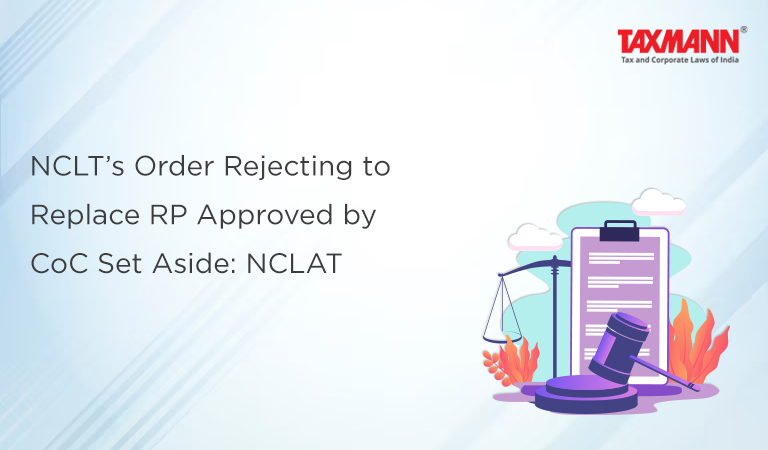NCLT’s Order Rejecting to Replace RP Approved by CoC Set Aside: NCLAT
- Blog|News|Insolvency and Bankruptcy Code|
- 3 Min Read
- By Taxmann
- |
- Last Updated on 26 April, 2023

Case Details: Venus India Asset-Finance (P.) Ltd. v. Suresh Kumar Jain, Resolution Professional of MK Overseas (P.) Ltd. - [2023] 149 taxmann.com 201 (NCLAT-New Delhi)
Judiciary and Counsel Details
-
- Justice Ashok Bhushan, Chairperson & Barun Mitra, Technical Member
- Brijesh Kumar Tamber, and Vinay Singh Bist, Advs. for the Appellant.
- P. Nagesh, Sr. Adv., Anoop Prakash, Ms Prapti Singh, Ms Parthvi Ahuja, Kunal Tandon, Ms Richa Sandilya and Shivangi Chawla, Advs. for the Respondent.
Facts of the Case
In the instant case, the corporate debtor was admitted to the CIRP following the admission of a section 7 application. Subsequently, a Resolution Professional (RP) was appointed and confirmed by the Committee of Creditors (CoC).
The CoC approved a resolution plan and the application u/s 30(6) of the IBC for the approval of the said resolution plan was pending before the Adjudicating Authority (NCLT).
Later, in a subsequent meeting, the CoC voted and approved a resolution for the replacement of the existing RP with a majority vote of 76.69%. They filed an application before the Adjudicating Authority (NCLT), along with written consent from the proposed RP in the specified form.
However, the National Company Law Tribunal (NCLT) rejected the said application on the ground that the IBC does not envisage any decision-making role for the CoC once it has approved a resolution plan and such a plan is pending adjudication before the NCLT.
Then, the appellant (i.e., financial creditor), filed an appeal to the National Company Law Appellant Tribunal (NCLAT) against the order passed by the NCLT.
The appellant contended that, in terms of section 27(2) of the IBC, the CoC of a corporate debtor could resolve to replace the RP appointed u/s 22 with another RP after putting such a resolution to vote and passing it by a voting share of 66%.
It was noted that the CoC had approved the resolution for the replacement of the existing RP by a voting share of 76.69%. However, despite following the statutory prescription laid down for the replacement of the RP, the proposal had been erroneously turned down by the NCLT.
NCLAT Held
The NCLAT observed that since there was no violation of statutory provisions in bringing about the replacement of the RP by the CoC, and all procedural compliances were met, the NCLT was duty-bound to abide by the discipline of statutory provisions.
The NCLAT, further held that since the NCLT was not invested with the jurisdiction and authority to review the decision exercised by the CoC to replace the RP. Therefore, the order of the NCLT rejecting the application for the replacement of the RP was a transgression of jurisdiction. Thus, the same deserved to be set aside.
List of Cases Reviewed
-
- Mayoga Investment Ltd. v. M.K. Overseas (P.) Ltd. [2023] 149 taxmann.com 200 (NCLT – New Delhi) (para 36) reversed [See Annex].
List of Cases Referred to
-
- Gulabchand Jain v. Ramchandra D. Chudhary, Resolution Professional of Vijay Timber Industries (P.) Ltd. [2021] 131 taxmann.com 149/[2022] 169 SCL 109 (NCL-AT) (para 7)
- Gulabchand Jain v. Ramchandra D. Chudhary [2021] 133 taxmann.com 208/[2022] 169 SCL 175 (SC) (para 7)
- ICICI Bank Ltd. v. Venkataramanarao Nagarajan [Company Appeal (AT) (Ins.) No. 772 of 2018, dated 13-12-2018] (para 11)
- Swiss Ribbons (P.) Ltd. v. Union of India [2019] 101 taxmann.com 389/152 SCL 365 (SC) (para 23)
- Sanjay Kumar Ruia v. Catholic Syrian Bank Ltd. [Company Appeal (AT) (Ins.) No. 560 of 2018, dated 3-1-2019] (para 31)
- State Bank of India v. Ram Dev International Ltd. [2018] 97 taxmann.com 58 (NCL-AT) (para 33)
- Sumant Kumar Gupta v. Committee of Creditors [Company (AT) Ins. No. 1037 of 2020, dated 2-9-2022] (para 33)
- Bank of India v. Nithin Nutritions (P.) Ltd. [2020] 118 taxmann.com 343 (NCL-AT) (para 33).
Disclaimer: The content/information published on the website is only for general information of the user and shall not be construed as legal advice. While the Taxmann has exercised reasonable efforts to ensure the veracity of information/content published, Taxmann shall be under no liability in any manner whatsoever for incorrect information, if any.

Taxmann Publications has a dedicated in-house Research & Editorial Team. This team consists of a team of Chartered Accountants, Company Secretaries, and Lawyers. This team works under the guidance and supervision of editor-in-chief Mr Rakesh Bhargava.
The Research and Editorial Team is responsible for developing reliable and accurate content for the readers. The team follows the six-sigma approach to achieve the benchmark of zero error in its publications and research platforms. The team ensures that the following publication guidelines are thoroughly followed while developing the content:
- The statutory material is obtained only from the authorized and reliable sources
- All the latest developments in the judicial and legislative fields are covered
- Prepare the analytical write-ups on current, controversial, and important issues to help the readers to understand the concept and its implications
- Every content published by Taxmann is complete, accurate and lucid
- All evidence-based statements are supported with proper reference to Section, Circular No., Notification No. or citations
- The golden rules of grammar, style and consistency are thoroughly followed
- Font and size that’s easy to read and remain consistent across all imprint and digital publications are applied





